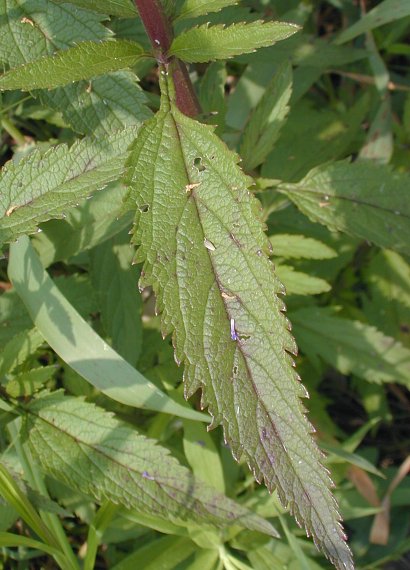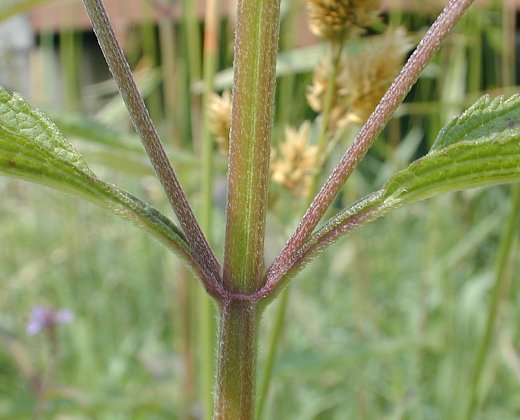Description:
This is a slender, but erect, herbaceous perennial plant that is up to
5'
tall. It branches occasionally along the upper half of its length. The
green to reddish stems
are four-angled, often with white appressed hairs. The opposite leaves
are up to 6" long and 1" across. They are lanceolate, conspicuously
veined, and their petioles are short. Leaf margins are coarsely
serrated. The upper stems terminate in panicles of
flowering spikes up to 1' long and about one-half as much across.
Individual floral spikes are up to 5" long, and densely
crowded all around with numerous blue-violet flowers. Individual
flowers are up to ¼" long and similarly across. Each flower has a
blue-violet corolla with 5 spreading lobes, a short-tubular calyx with
5 narrow teeth, 4 inserted stamens, and a pistil. The calyx is grayish
green to dark red and about one-half as long as the corolla. The
blooming period occurs from mid- to late summer, lasting about 1–1½
months. There is no noticeable floral scent. Afterwards, the flowers
are replaced by small nutlets (4 nutlets per flower). These nutlets are
up to 2 mm. long, reddish brown, and oblongoid in shape. The root
system is fibrous and rhizomatous. Small clonal colonies of plants are
often produced from the rhizomes.

Cultivation:
The preference is full to partial sunlight, moist conditions, and soil
consisting of fertile loam or wet muck. This plant tolerates
standing water if it is temporary. This is a good plant to locate near
a small river or pond in a sunny location.
Range & Habitat:
Blue Vervain occurs in every county of Illinois (see Distribution
Map), where it is fairly common and native. Habitats include
riverbottom
prairies, moist meadows in floodplain woodlands, soggy thickets,
borders of rivers and ponds, marshes, ditches, fence rows, and
pastures. This plant adapts readily to degraded wetlands and other
disturbed areas, but it can be found in higher quality habitats as well.

Faunal Associations: The flowers of Blue Vervain attract many kinds of long-tongued and short-tongued bees, including honey bees, bumblebees, cuckoo bees (Triepeolus spp.), digger bees (Melissodes spp.), Halictid bees, and dagger bees (Calliopsis spp.), including the oligolectic Verbena Bee (Calliopsis verbenae). These bees seek primarily nectar, although some species collect pollen. Other floral visitors include Sphecid wasps, Vespid wasps, Syrphid flies, bee flies (Exoprosopa spp.), thick-headed flies (Physocephala spp.), small butterflies, skippers, and moths (Robertson, 1929). Other insects feed on the leaves and other parts of Blue Vervain and other Verbena spp. Examples of such insects include both adults and larvae of a flea beetle (Longitarsus suspectus), larvae of the Vervain Leaf Midge (Clinodiplosis verbenae), the Verbena Aphid (Macrosiphum verbenae), leaf-eating larvae of the Verbena Moth (Crambodes talidiformis), and larvae of the Verbena Bud Moth (Endothenia hebesana); see Clark et al. (2004), Felt (1917), Thomas (1877), Covell (1984/2005), and Miller (1987). Mammalian herbivores usually avoid eating this plant because of its bitter leaves – an exception is the Cottontail Rabbit, which may eat the foliage of young plants to a limited extent. Also, various songbirds occasionally eat the seeds, including the Cardinal, Swamp Sparrow, Field Sparrow, Song Sparrow, and Slate-Colored Junco (Martin et al., 1951/1961). Experimental studies have shown that these seeds can pass undamaged through the digestive tracts of cattle, therefore they are probably distributed to some extent by these seed-eating birds.

Photographic
Location:
The photographs were taken at Meadowbrook Park in Urbana, Illinois.
Comments:
The flowers are often a pretty shade of blue-violet, but they are small
in size. Among the various Verbena
spp. in Illinois, Blue Vervain
(Verbena hastata)
is easy to identify because it is the only vervain
with elegant spikes of flowers in this color range. Other Verbena spp.
within the state, excluding introduced cultivated species, have white,
pink, or lavender flowers.